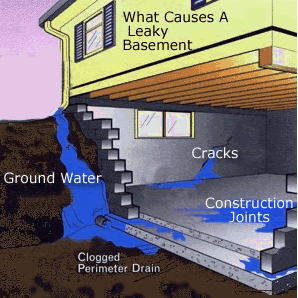 When it comes to choosing waterproofing products, the location and type of home you own can affect which interior and exterior solutions are best for you and your situation. There are pros and cons associated with each application, and we’ll discuss several ways you can do the task as well as help you decide whether you should be using interior or exterior basement waterproofing.
When it comes to choosing waterproofing products, the location and type of home you own can affect which interior and exterior solutions are best for you and your situation. There are pros and cons associated with each application, and we’ll discuss several ways you can do the task as well as help you decide whether you should be using interior or exterior basement waterproofing.
Regardless of what type of waterproofing solution you choose, you must repair cracks and holes in the basement walls. Patching these can be a challenge. For interior basement waterproofing you will need to brush away loose concrete to get a decent surface. You will need to use this concrete to fill holes and cracks and then smooth it out. When you waterproof the exterior, the cracks and holes aren’t so much of an issue.
An advantage to using exterior waterproofing is skin shielding. Skin shielding is only used with exterior waterproofing. It is a skin that is placed over the exterior basement wall after waterproofing paint has been applied. The skin acts as a moisture barrier between the cool soil and the excess water. This skin is even rubberized and is manufactured in a honeycomb design.
Interior and exterior basement waterproofing will always use waterproof paint. The paint is applied like any other kind of paint, and is usually latex based. This means it doesn’t allow water to adhere to it or degrade it over time. Exterior waterproofing paint is more durable than interior paint due to the constant bombardment by moisture and rain.
Facilitating good drainage is an extremely important step when waterproofing a basement space. In order to keep the interior of the basement dry you need to install the drainage outside the home. There are many ways this can be done with the simplest being pipes like downspouts. Another way is to create a trench at the base of the exterior wall and place a drain pipe inside it, connecting it to the exterior plumbing line. This will keep water away from the concrete foundation and out of your basement.
When choosing exterior basement waterproofing, a water sock is often the choice among building professionals. The water sock is a round piece of absorbent material wrapped in mesh. The land around your home is excavated to the base of the foundation. Then, a trench is dug and filled with an inch of sand. The water sock is then placed and set in the sand and covered with gravel. This is done around the perimeter of the property and then the earth is backfilled over the water sock and leveled. When it rains, the water soaks through the ground around your home and reaches the gravel. The water then filters through the gravel and into the water sock, where its stored. Over time, the water is slowly released back into the ground, preventing an abundance of moisture that could overwhelm your waterproofing.
